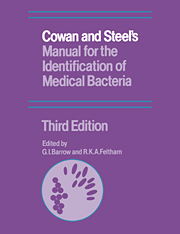Book contents
- Frontmatter
- Contents
- Foreword
- Preface to the first edition
- Postscript
- Preface to the second edition
- Preface to the third edition
- List of contributors
- Introduction
- 1 Classification and nomenclature
- 2 Culture media: constituents and sterilization
- 3 Principles of isolation
- 4 Bacterial characters and characterization
- 5 Theory and practice of bacterial identification
- 6 Characters of Gram-positive bacteria
- 7 Characters of Gram-negative bacteria
- 8 Taxonomy in theory and practice
- 9 Bacterial identification by cards
- 10 Bacterial identification by computer
- 11 Quality control in microbiology
- Appendices
- References
- Index
6 - Characters of Gram-positive bacteria
Published online by Cambridge University Press: 15 December 2009
- Frontmatter
- Contents
- Foreword
- Preface to the first edition
- Postscript
- Preface to the second edition
- Preface to the third edition
- List of contributors
- Introduction
- 1 Classification and nomenclature
- 2 Culture media: constituents and sterilization
- 3 Principles of isolation
- 4 Bacterial characters and characterization
- 5 Theory and practice of bacterial identification
- 6 Characters of Gram-positive bacteria
- 7 Characters of Gram-negative bacteria
- 8 Taxonomy in theory and practice
- 9 Bacterial identification by cards
- 10 Bacterial identification by computer
- 11 Quality control in microbiology
- Appendices
- References
- Index
Summary
In characterization by stages, the first-stage table is combined with a figure and shows how, with a small number of selected characters, Gram-positive bacteria can be divided into groups that correspond to those used in orthodox classifications. Not all of the theoretically possible combinations of characters are shown in Table 6.1 because many of them do not seem to occur in nature. Each shaded square indicates the genus or genera that have the characters shown in the same column in the table above it. Equivocal characters, those difficult to determine, and characters markedly influenced by culture medium or test method can make a genus span more than one column; we have therefore tried to concentrate on the reactions given by most strains of a species in the kind of media likely to be used in routine diagnostic laboratories (majority reactions or characters) though in doing this we may perhaps have introduced a tidiness that is not warranted by the biological nature of the scheme. An example of generic spread is seen with Aerococcus, which appears in the third and fourth columns of Table 6.1; in this case, the reason for the spread is that the catalase reaction is not always easy to read and may be interpreted in different ways by different workers. Those who expect a large volume of gas to be produced may record the feeble reaction of A.
- Type
- Chapter
- Information
- Publisher: Cambridge University PressPrint publication year: 1993
- 14
- Cited by



